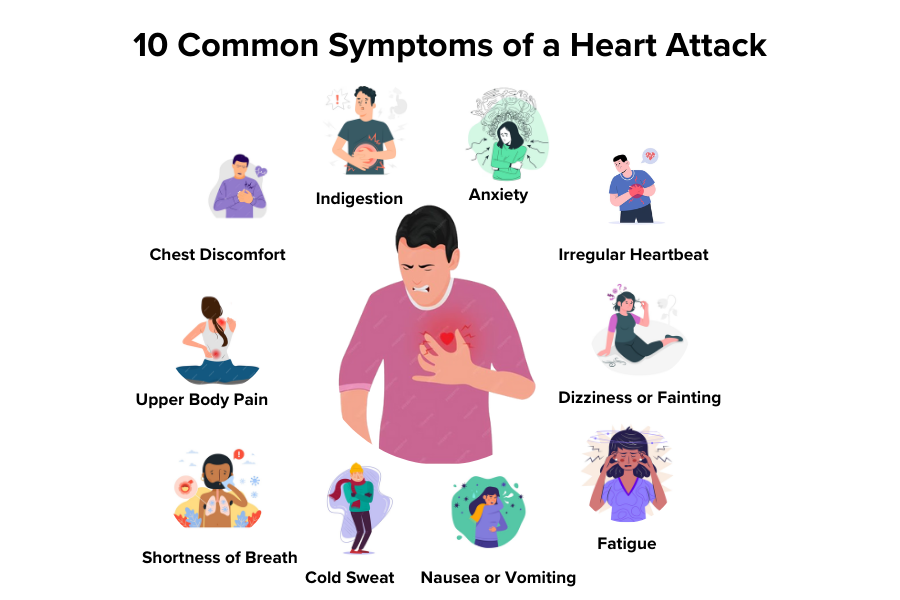
Myocardial infarction (commonly known as a heart attack) is a growing public health concern globally, including in sub-Saharan Africa (SSA). Yet, despite its increasing prevalence, many misconceptions and myths still surround this condition.
Myocardial infarction is often viewed as an inevitable fatality or something that cannot be prevented. However, heart attacks are medical emergencies that require rapid response and specialized care to save lives and prevent long-term damage.
In this blog, we will address the key facts about myocardial infarction, debunk some of the common myths, and highlight the importance of early detection and treatment to improve survival rates and reduce complications.
What is myocardial infarction?
A myocardial infarction occurs when blood flow to a part of the heart muscle is severely reduced or completely blocked.
This is usually caused by a blockage in one or more coronary arteries, often due to a build-up of fatty deposits (plaque) or a blood clot.
When the heart muscle is deprived of oxygen, the affected tissue begins to die, leading to permanent damage if not treated quickly.
Common myths about heart attacks
Despite medical advancements, many people in SSA still hold misconceptions about heart attacks. Here are some common myths, and the facts you need to know:
- Myth 1: Heart attacks are only a problem for the elderly.
Fact: While the risk of myocardial infarction increases with age, younger adults (especially men over 45 and women over 55) can also experience heart attacks, particularly if they have risk factors like black race, hypertension, diabetes, smoking, obesity, or a sedentary lifestyle. - Myth 2: A heart attack is always fatal.
Fact: With rapid treatment, many people survive heart attacks and go on to live healthy lives. The key to survival is recognizing the signs early and seeking immediate medical attention. - Myth 3: Heart attacks are sudden and always dramatic.
Fact: While some heart attacks occur suddenly and with intense chest pain, others develop slowly with milder symptoms like discomfort, shortness of breath, nausea, or fatigue. These symptoms may be mistaken for less severe conditions like indigestion, especially in women and older adults. - Myth 4: You can recover from a heart attack on your own if you rest.
Fact: A heart attack is a life-threatening emergency, and delaying treatment can cause irreversible damage to the heart muscle or lead to death. Resting at home is not enough. Immediate medical care is essential.
Recognizing the symptoms of a heart attack
The key to surviving a heart attack is early recognition of the symptoms. Some of the most common symptoms of myocardial infarction include:
- Chest pain or discomfort, often described as pressure, tightness, or a squeezing sensation that may spread to the arms, neck, back, or jaw.
- Shortness of breath, which can occur with or without chest discomfort.
- Nausea, vomiting, lightheadedness, or sudden dizziness.
- Cold sweats or an overwhelming sense of anxiety.
It’s important to remember that symptoms can vary between individuals, and women, in particular, may experience less typical signs like back or jaw pain, fatigue, or indigestion.
Why Early Treatment Matters
When it comes to myocardial infarction, time is muscle—every minute counts. The sooner you receive treatment, the better your chances of limiting the damage to the heart muscle and preventing complications. Immediate treatment can save your life and significantly reduce the risk of long-term health problems.
Delaying treatment can lead to severe consequences such as:
- Heart Failure: When a large portion of the heart muscle is damaged, it can no longer pump blood efficiently, leading to heart failure, a chronic condition that requires ongoing treatment.
- Arrhythmias: Abnormal heart rhythms can occur as a result of the heart attack, which can be life-threatening if not treated promptly.
- Sudden Cardiac Arrest: In some cases, a heart attack can trigger a sudden, life-threatening arrhythmia that causes the heart to stop beating, known as cardiac arrest.
Be in the look out for any of these, especially if they occur in combination

The importance of high suspicion and early action
The key to preventing fatal outcomes and severe complications lies in recognizing the signs of a heart attack early and acting fast. Here are the critical steps:
- Maintain a High Suspicion Index: Given the common misconceptions, it’s important to take symptoms like chest pain or shortness of breath seriously, especially in individuals with known risk factors such as high blood pressure, diabetes, smoking, or a family history of heart disease.
- Seek Medical Help Immediately: If you or someone you know is experiencing any signs of a heart attack, do not wait. Call emergency services or get to the nearest hospital as quickly as possible. Early intervention with medications like blood thinners or procedures like angioplasty can restore blood flow to the heart and prevent more extensive damage.
- Reach a Specialized Center: Getting to a specialized cardiac center as quickly as possible is crucial for receiving life-saving interventions, including clot-busting drugs, angioplasty, or coronary artery bypass surgery if needed.
Long-term consequences of delayed or inadequate treatment
If a heart attack is not treated promptly or adequately, the damage to the heart muscle can become permanent. This can lead to long-term consequences such as:
- Reduced Quality of Life: People who survive a heart attack but receive delayed or inadequate treatment may experience reduced physical capacity, persistent fatigue, and difficulty performing daily activities due to weakened heart function.
- Increased Risk of Future Heart Attacks: After a heart attack, the chances of having another one increase, especially if lifestyle changes and medical treatments are not implemented.
- Shortened Life Expectancy: The long-term health of the heart is closely tied to how quickly and effectively a heart attack is treated. Those who experience severe damage to their heart muscle may face a shortened life expectancy.
Hopeful outlook: Prevention and early detection
Although myocardial infarction is a serious condition, it can be prevented and effectively managed with early detection and treatment. Adopting heart-healthy lifestyle habits can significantly lower the risk of heart attacks:
- Regular physical activity: Engaging in at least 150 minutes of moderate-intensity aerobic activity per week can help strengthen the heart and improve overall cardiovascular health.
- Healthy eating habits: A diet rich in fruits, vegetables, whole grains, and lean proteins can reduce the risk of heart disease.
- Managing risk factors: Controlling high blood pressure, high cholesterol, and diabetes, along with quitting smoking, can greatly reduce the chances of a heart attack.
Remember
Myocardial infarction – A problem that demands attention and urgent action
Myocardial infarction is no longer an inevitable fatality. It is a medical emergency that requires swift action, a high level of suspicion, and proper medical care.
By dispelling the myths and taking heart attacks seriously, we can save more lives. If you or a loved one experiences the warning signs of a heart attack, remember that every minute counts. Seek immediate care, and do not delay.
In sub-Saharan Africa, there is an urgent need to raise awareness about the dangers of heart attacks and promote early intervention.
With proper education and the expansion of specialized cardiac centers, more lives can be saved, and many of the long-term complications of myocardial infarction can be avoided.


